| Article ID | Journal | Published Year | Pages | File Type |
|---|---|---|---|---|
| 13463183 | Cities | 2020 | 9 Pages |
Abstract
Community participation is an essential issue in heritage management. The international heritage organisation ICCROM published a guidance document discussing people-centred approaches to heritage management in 2015. Cultural heritage management is recommended to be carried out through a community participation process. Despite the growing literature on community participation in cultural heritage management, little research has been done on comparing Chinese to international approaches. Although in China several pilot projects have conducted effective community participation and achieved excellent outcomes. This paper aims to fill this gap by providing an overview that compares and discusses the similarities and differences between Chinese and international approaches. A systematic literature review of the state-of-the-art was conducted to explore these differences based on four themes: engaged communities, participatory methods, degrees of participation and steps taken within cultural heritage management. This review concludes both Chinese and international practices seek to collaborate with and empower local communities in their approaches, with Chinese pilot cases, such as Tianzifang in Shanghai. However, in general, Chinese cultural heritage management is government-led, in which community participation is happening to a minimal degree. China is encouraged to learn from international practices when developing contextualised management approaches, to better face the challenges of rapid urbanisation.
Related Topics
Social Sciences and Humanities
Business, Management and Accounting
Tourism, Leisure and Hospitality Management
Authors
Ji Li, Sukanya Krishnamurthy, Ana Pereira Roders, Pieter van Wesemael,
